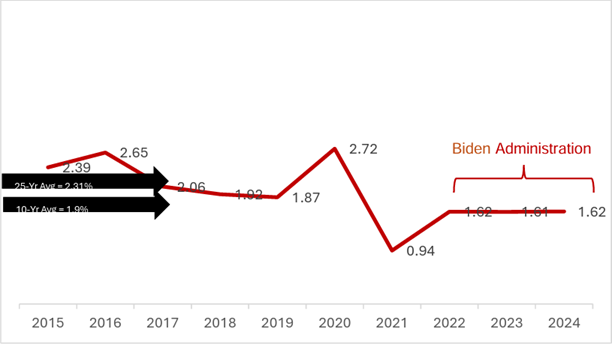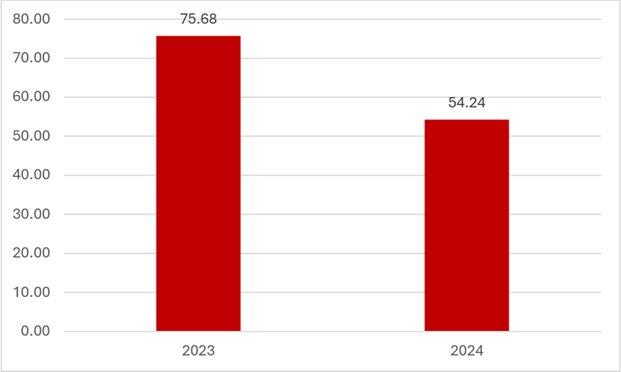Amanda Wait, Partner and Antitrust & Competition Leader, authored an article for Law360, now available in full on our website.
Recently released statistics from the Federal Trade Commission and the Antitrust Division of the U.S. Department of Justice paint an optimistic picture of merger enforcement for companies considering potential transactions in 2024 and beyond.
Analysis of the agencies' Hart-Scott-Rodino Act annual report for fiscal year 2024 reveals that merger activity is up, merger enforcement is down and, despite public rhetoric to the contrary, the vast majority of deals are emerging from U.S. federal antitrust review unscathed.
Parties considering deal transactions should still carefully weigh the specific antitrust risks of any given transaction, but companies should not shy away from deals based on a perception that recent antitrust enforcement has been unusually aggressive. Data shows generally consistent antitrust enforcement over time.
Biden Administration Antimerger Rhetoric
Since 1977, the FTC and the DOJ's Antitrust Division have annually reported to Congress statistics on their activities pursuant to the Hart-Scott-Rodino Antitrust Improvements Act.[1] On Sept. 17, the agencies released the HSR annual report, which covers federal merger enforcement activity from Oct. 1, 2023, through Sept. 30, 2024.[2]
This time period covers the government's last full fiscal year under the Biden administration.
During the Biden administration, key antitrust enforcement officials widely touted their strong antitrust enforcement approach. For example, during a Jan. 8 speech at the Brookings Institution in the waning days of the Biden administration, then-FTC Chair Lina Khan touted the agencies' big victories on merger cases.[3]
In his Dec. 17, 2024, farewell address, Jonathan Kanter, the Biden administration's assistant attorney general for the Antitrust Division at the DOJ, outlined how, under his leadership, the Antitrust Division sought to "restore, revive, and reimagine antitrust enforcement," after "a deliberate and decades-long effort to dismantle the intellectual, legal, and operational infrastructure of antitrust enforcement."[4]
The public message was clear: The antitrust cops were back on the beat and using all tools in their toolbox to protect competition.
These and many other public statements by key antitrust officials during the Biden administration translated into a perception that potential deals should not make it out of the boardroom, and, if they did, they likely would face significant antitrust scrutiny.
At least some evidence shows this rhetoric had a deterrent effect. From fiscal year 2021 to fiscal year 2024, the number of transactions reported under the HSR Act decreased from more than 3,400 to fewer than 2,000 annually.[5]
Even though the data shows a slight increase from fiscal year 2023 to fiscal year 2024, the number of adjusted reported transactions in fiscal year 2024 remained below the 10-year average of 2,131.
Chart 1: Adjusted Reported Transactions by Fiscal Year[6]

HSR Annual Reports Show Generally Consistent Merger Enforcement
The FTC and DOJ's joint HSR annual reports provide a wealth of data regarding enforcement under the HSR Act. Since HSR-reportable deals comprise almost all merger enforcement by the federal antitrust enforcers, this annual data provides a consistent measure of the state of merger enforcement over time.
Interestingly, the reported data since fiscal year 2000 shows merger enforcement has been reasonably consistent over time. Even variation between presidential administrations is limited.[7]
The agencies report both the total number of deals reported subject to the HSR Act — adjusted reported transactions — and also the number of merger challenges brought during that fiscal year. For the purposes of this data, challenges include deals that:
- The agency filed a complaint in either federal district court or, in the case of the FTC, before an administrative law judge, seeking an injunction to block the deal;
- Were abandoned by the parties before the agency filed a complaint; and
- Were restructured after the agency raised concerns, either through a formal consent process or voluntarily by the parties — regardless of the reason for the restructuring.
Considering the number of challenges as a percentage of the adjusted number of deals reported under the act enables a consistent apples-to-apples comparison of relative enforcement activity over time.
This data shows both, on average, that merger enforcement has remained generally consistent over time, and also that the range of enforcement data is narrow. For example, since fiscal year 2000, challenges as a percentage of adjusted reported transactions have averaged 2.31%.
Over this time, the range of enforcement activity is fairly narrow: The highest percentage of reported deals challenged was 4.53% in fiscal year 2009, and the lowest was 0.94% in fiscal year 2021.
Chart 2: Transactions Challenged as a Percentage of Adjusted Reported Transactions[8]

Analysis of these same statistics by presidential administration demonstrates further consistency within a narrow range.[9]
Chart 3: Average Transactions Challenged as a Percentage of Adjusted Reported Transactions by Presidential Administration[10]

Notably, this data also shows that the Biden administration challenged fewer mergers, on average, as compared to other presidential administrations during the past 25 years.
Merger Enforcement in Fiscal Year 2024 Lower Than the 10-Year Average
A deeper dive into the fiscal year 2024 data further shows that merger enforcement was lower in that year than historical averages and even other recent years in the same administration. This is not what one might think, given the strong enforcement statements from the key antitrust enforcers during that time.
Interestingly, despite lower overall numbers of mergers being reported in fiscal year 2024 — see Chart 1 above — the size of the reported transactions skewed slightly larger.
In fiscal year 2024, over 26.3% of reported transactions had an asset value for the to-be-acquired entity of greater than $1 billion. Only 22.4% of transactions reported in fiscal year 2023 were at this same level.
Chart 4: HSR Reported Deals by Transaction Size[11]

Larger transactions might suggest increased enforcement given the Biden administration's focus on reversing the so-called dangerous trends of industry consolidation.[12]
But, in fact, that wasn't the case. Merger challenges as a percentage of adjusted reported transactions were lower than in prior years. The FTC and DOJ challenged only 1.6% of reported transactions in fiscal year 2024. This is lower than both the 10-year average of 1.9% and the 25-year average of 2.31%.
Chart 5: Transactions Challenged as a Percentage of Adjusted Reported Transactions (Last 10 Years)[13]

Another telling statistic is what happens to deals after a significant inquiry is launched. The HSR Act provides for a 30-day initial waiting period during which the reviewing agency can make a preliminary assessment of the potential antitrust risk of a reported transaction.
Prior to the end of that 30-day waiting period, the reviewing agency can either allow the waiting period to expire and allow the parties to close, or issue a second request to continue their investigation. A second request is a substantial document and information request that tolls the waiting period until the parties substantially comply with the second request.
The receipt of a second request in a transaction is an indication that the reviewing agency has preliminary concerns about the proposed transaction and would like to further investigate.
During the Biden administration,[14] on average, 78% of reported transactions that received a second request ultimately were challenged. This average is consistent with both the average under Trump's first term (79.52%) and the 10-year average (77.87%). However, this average masks that the percentage declined significantly during Biden's term.
Chart 6: Merger Challenges as a Percentage of Second Requests By Fiscal Year[15]

After three years of data, this statistic decreased by almost half to 54.24%. This is the lowest percentage of transactions receiving second requests that were challenged in 14 years, since President George W. Bush's administration in fiscal year 2007.
The Bottom Line: It's Not As Bad As It May Seem…
Parties contemplating potential transactions in 2025 and beyond should know that merger control is not an insurmountable hurdle in most transactions. While some transactions can raise antitrust scrutiny, this risk is transaction-specific.
The FTC and DOJ's data show that less than 3% of reported transactions in fiscal year 2024 received a second request and less than 2% were challenged.
This means that the vast majority of reported transactions are clearing U.S. antitrust review unscathed. Don't just read the headlines and assume antitrust scrutiny awaits.
Amanda Wait is a partner and the leader of the antitrust and competition practice at Michael Best & Friedrich LLP. She previously served as a staff attorney at the Federal Trade Commission.
The opinions expressed are those of the author(s) and do not necessarily reflect the views of their employer, its clients, or Portfolio Media Inc., or any of its or their respective affiliates. This article is for general information purposes and is not intended to be and should not be taken as legal advice.
- The most recent report covering Fiscal Year 2024 marks the 47th annual report under the Act. All 47 reports are available at https://www.ftc.gov/policy/reports/annual-competition-reports.
- The reports are usually released approximately one year after the end of the prior fiscal year.
- See Remarks by Chair Lina Khan at Brookings Institution Fireside Chat, Jan. 8, 2025, at https://www.ftc.gov/system/files/ftc_gov/pdf/remarks-chair-lina-m-khan-brookings-institution.pdf.
- Assistant Attorney General Jonathan Kanter Delivers Farewell Address, Dec. 17. 2024, at https://www.justice.gov/archives/opa/speech/assistant-attorney-general-jonathan-kanter-delivers- farewell-address.
- During this same time period the HSR "size of transaction" test which is the minimum value of assets to be held as a result of the acquisition also increased from $92 million in 2021 to $119.5 million. This threshold amount is adjusted annually based on changes in the gross national product. This increase in the minimum reporting size of transaction likely accounts for at least some of the reduction in reported deals. See HSR threshold adjustments and reportability for 2021, at https://www.ftc.gov/enforcement/competition-matters/2021/02/hsr-threshold-adjustments- reportability-2021; New HSR Thresholds and Filing Fees for 2024, at https://www.ftc.gov/enforcement/competition-matters/2024/02/new-hsr-thresholds-filing-fees-2024.
- Annual HSR Reports to Congress, Appendix A, available at https://www.ftc.gov/policy/reports/annual-competition-reports.
- The HSR Annual Reports provide data based on the U.S. Federal Government's fiscal year, which runs from October 1, through September 30. Accordingly, those fiscal years do not directly correlate with a Presidential Administration.
- Author calculations based on Annual HSR Reports to Congress, available at https://www.ftc.gov/policy/reports/annual-competition-reports.
- The HSR Annual Reports are based on data covering the government's fiscal year (October 1 through September 30). This does not correspond to the dates of Presidential Administrations. To account for this timing discrepancy, years that span multiple Administrations are removed from the data. As a result, the Bush Administration data is based on the HSR Annual Reports for Fiscal Years 2002 through 2008; the Obama Administration data on Fiscal Years 2010 through 2016; the Trump Administration data on Fiscal Years 2018 through 2020, and the Biden Administration data on Fiscal Years 2022 through 2024.
- Author calculations based on Annual HSR Reports to Congress, available at https://www.ftc.gov/policy/reports/annual-competition-reports.
- Author calculations based on Annual HSR Reports to Congress, available
at https://www.ftc.gov/policy/reports/annual-competition-reports.
[12] Exec. Order No. 14,036, 86 Fed. Reg. 36,987, 36,991 (July 9, 2021).
- Author calculations based on Annual HSR Reports to Congress, available at https://www.ftc.gov/policy/reports/annual-competition-reports.
- Fiscal Years 2022 through 2024. See note 9 above.
- Author calculations based on Annual HSR Reports to Congress, available at https://www.ftc.gov/policy/reports/annual-competition-reports.



/Passle/5f6edd8e8cb62a0bec3e5fd2/SearchServiceImages/2025-09-11-17-02-51-670-68c300bb2b4d83f984228268.jpg)
/Passle/5f6edd8e8cb62a0bec3e5fd2/SearchServiceImages/2025-11-03-17-28-25-444-6908e6396964a8f1db8d3c55.jpg)
/Passle/5f6edd8e8cb62a0bec3e5fd2/SearchServiceImages/2025-12-11-03-07-32-500-693a357483358cbce8014c12.jpg)
/Passle/5f6edd8e8cb62a0bec3e5fd2/MediaLibrary/Images/2025-12-17-03-59-36-306-69422aa8e452dd14330072e0.png)